Peter Faber Business School: ACCT300 Auditing Assignment
VerifiedAdded on 2023/01/03
|10
|1567
|50
Homework Assignment
AI Summary
This assignment solution addresses ethical issues and social responsibilities in auditing, using KPMG as a case study. The assignment requires an analysis of the purpose and nature of external financial audits, as interpreted by KPMG, and an examination of its social responsibility initiatives, including specific examples. The solution also explores ethical dilemmas within a hypothetical auditing scenario, focusing on conflicts of interest and threats to objectivity, professional behavior, and intimidation. It identifies and discusses potential breaches of ethical principles and the responsibilities of auditors in maintaining integrity and transparency. The assignment covers key aspects of the auditing process, including client acceptance, audit evidence, and the importance of internal controls.
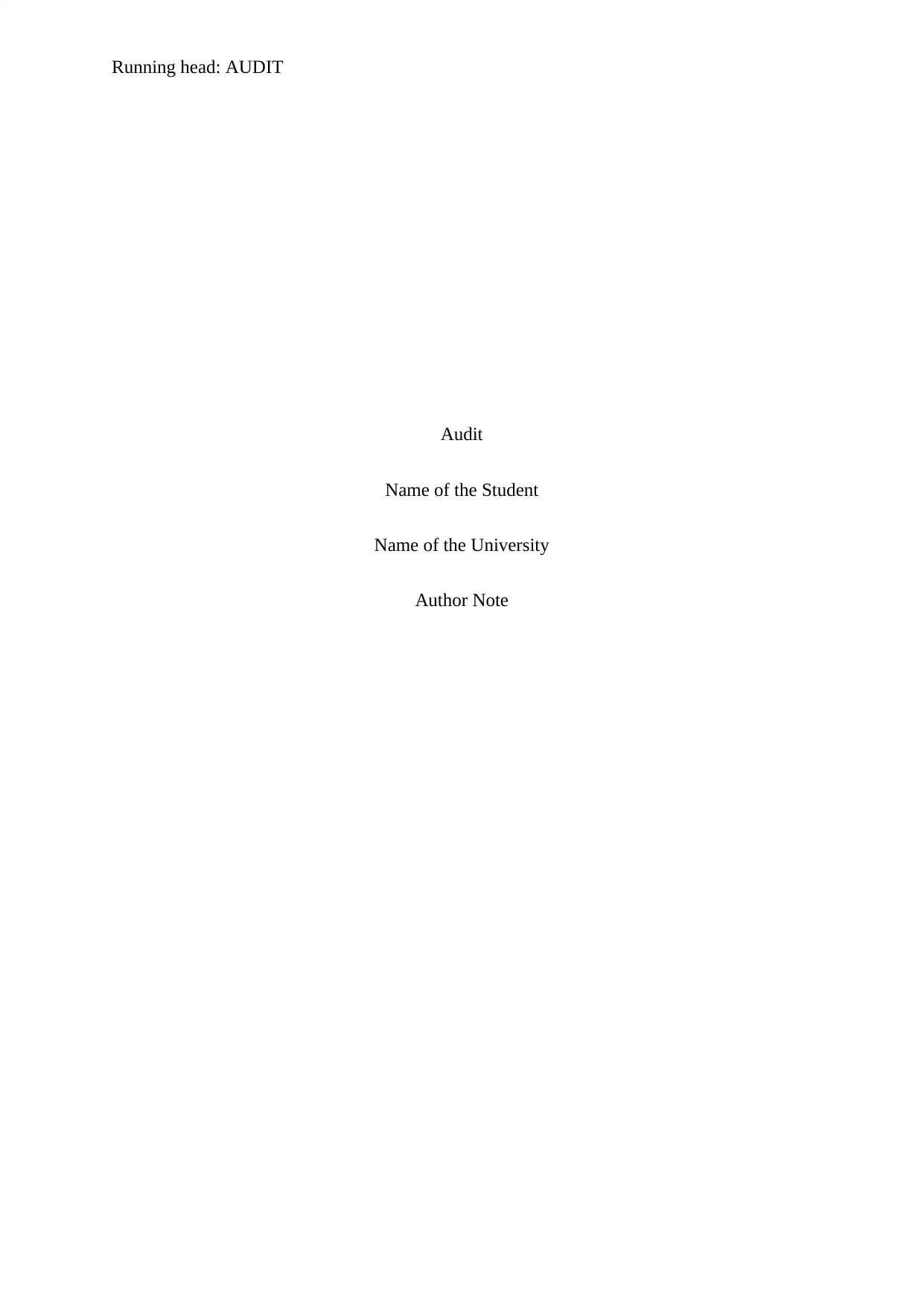
Running head: AUDIT
Audit
Name of the Student
Name of the University
Author Note
Audit
Name of the Student
Name of the University
Author Note
Secure Best Marks with AI Grader
Need help grading? Try our AI Grader for instant feedback on your assignments.
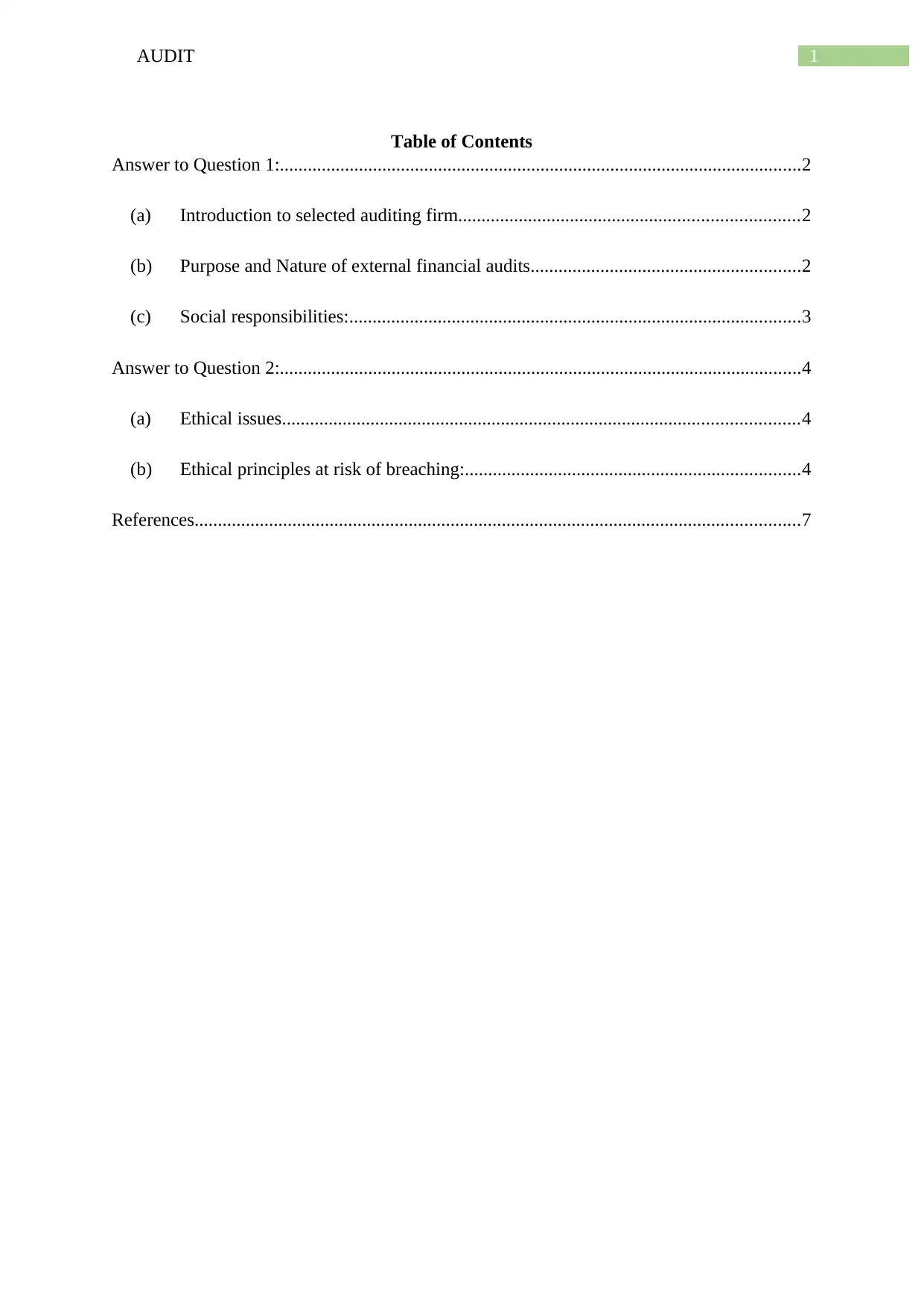
1AUDIT
Table of Contents
Answer to Question 1:................................................................................................................2
(a) Introduction to selected auditing firm.........................................................................2
(b) Purpose and Nature of external financial audits..........................................................2
(c) Social responsibilities:.................................................................................................3
Answer to Question 2:................................................................................................................4
(a) Ethical issues...............................................................................................................4
(b) Ethical principles at risk of breaching:........................................................................4
References..................................................................................................................................7
Table of Contents
Answer to Question 1:................................................................................................................2
(a) Introduction to selected auditing firm.........................................................................2
(b) Purpose and Nature of external financial audits..........................................................2
(c) Social responsibilities:.................................................................................................3
Answer to Question 2:................................................................................................................4
(a) Ethical issues...............................................................................................................4
(b) Ethical principles at risk of breaching:........................................................................4
References..................................................................................................................................7
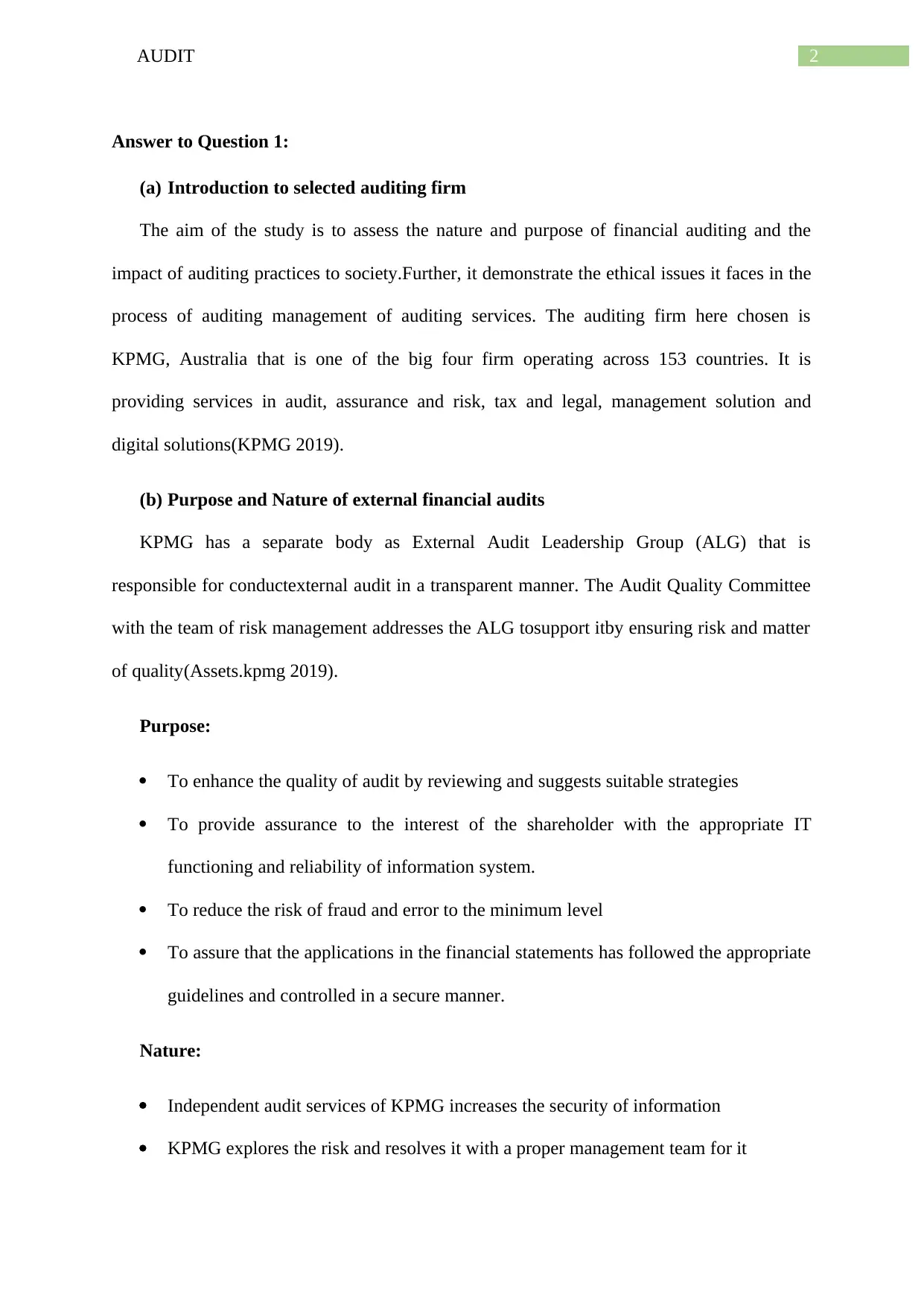
2AUDIT
Answer to Question 1:
(a) Introduction to selected auditing firm
The aim of the study is to assess the nature and purpose of financial auditing and the
impact of auditing practices to society.Further, it demonstrate the ethical issues it faces in the
process of auditing management of auditing services. The auditing firm here chosen is
KPMG, Australia that is one of the big four firm operating across 153 countries. It is
providing services in audit, assurance and risk, tax and legal, management solution and
digital solutions(KPMG 2019).
(b) Purpose and Nature of external financial audits
KPMG has a separate body as External Audit Leadership Group (ALG) that is
responsible for conductexternal audit in a transparent manner. The Audit Quality Committee
with the team of risk management addresses the ALG tosupport itby ensuring risk and matter
of quality(Assets.kpmg 2019).
Purpose:
To enhance the quality of audit by reviewing and suggests suitable strategies
To provide assurance to the interest of the shareholder with the appropriate IT
functioning and reliability of information system.
To reduce the risk of fraud and error to the minimum level
To assure that the applications in the financial statements has followed the appropriate
guidelines and controlled in a secure manner.
Nature:
Independent audit services of KPMG increases the security of information
KPMG explores the risk and resolves it with a proper management team for it
Answer to Question 1:
(a) Introduction to selected auditing firm
The aim of the study is to assess the nature and purpose of financial auditing and the
impact of auditing practices to society.Further, it demonstrate the ethical issues it faces in the
process of auditing management of auditing services. The auditing firm here chosen is
KPMG, Australia that is one of the big four firm operating across 153 countries. It is
providing services in audit, assurance and risk, tax and legal, management solution and
digital solutions(KPMG 2019).
(b) Purpose and Nature of external financial audits
KPMG has a separate body as External Audit Leadership Group (ALG) that is
responsible for conductexternal audit in a transparent manner. The Audit Quality Committee
with the team of risk management addresses the ALG tosupport itby ensuring risk and matter
of quality(Assets.kpmg 2019).
Purpose:
To enhance the quality of audit by reviewing and suggests suitable strategies
To provide assurance to the interest of the shareholder with the appropriate IT
functioning and reliability of information system.
To reduce the risk of fraud and error to the minimum level
To assure that the applications in the financial statements has followed the appropriate
guidelines and controlled in a secure manner.
Nature:
Independent audit services of KPMG increases the security of information
KPMG explores the risk and resolves it with a proper management team for it
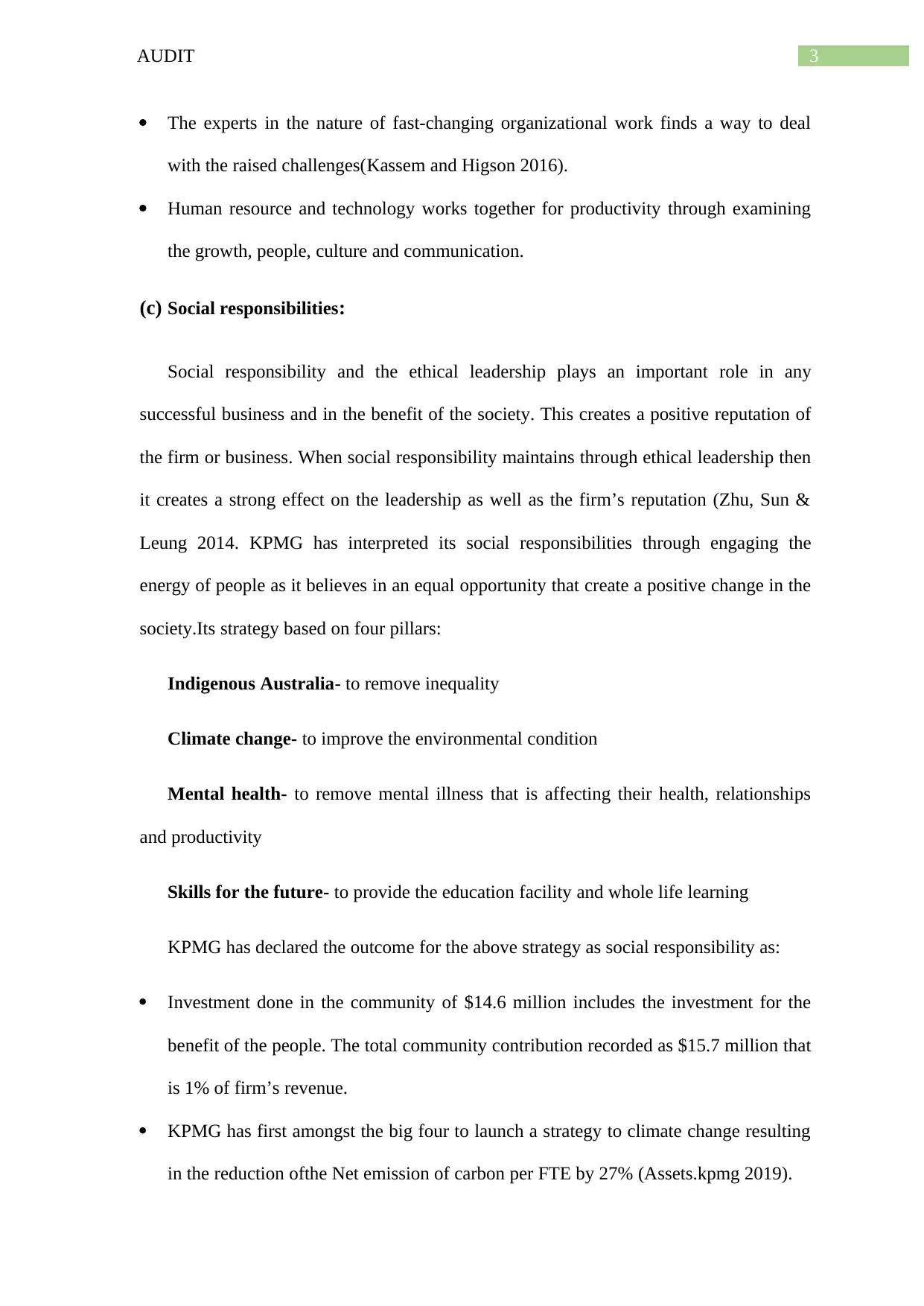
3AUDIT
The experts in the nature of fast-changing organizational work finds a way to deal
with the raised challenges(Kassem and Higson 2016).
Human resource and technology works together for productivity through examining
the growth, people, culture and communication.
(c) Social responsibilities:
Social responsibility and the ethical leadership plays an important role in any
successful business and in the benefit of the society. This creates a positive reputation of
the firm or business. When social responsibility maintains through ethical leadership then
it creates a strong effect on the leadership as well as the firm’s reputation (Zhu, Sun &
Leung 2014. KPMG has interpreted its social responsibilities through engaging the
energy of people as it believes in an equal opportunity that create a positive change in the
society.Its strategy based on four pillars:
Indigenous Australia- to remove inequality
Climate change- to improve the environmental condition
Mental health- to remove mental illness that is affecting their health, relationships
and productivity
Skills for the future- to provide the education facility and whole life learning
KPMG has declared the outcome for the above strategy as social responsibility as:
Investment done in the community of $14.6 million includes the investment for the
benefit of the people. The total community contribution recorded as $15.7 million that
is 1% of firm’s revenue.
KPMG has first amongst the big four to launch a strategy to climate change resulting
in the reduction ofthe Net emission of carbon per FTE by 27% (Assets.kpmg 2019).
The experts in the nature of fast-changing organizational work finds a way to deal
with the raised challenges(Kassem and Higson 2016).
Human resource and technology works together for productivity through examining
the growth, people, culture and communication.
(c) Social responsibilities:
Social responsibility and the ethical leadership plays an important role in any
successful business and in the benefit of the society. This creates a positive reputation of
the firm or business. When social responsibility maintains through ethical leadership then
it creates a strong effect on the leadership as well as the firm’s reputation (Zhu, Sun &
Leung 2014. KPMG has interpreted its social responsibilities through engaging the
energy of people as it believes in an equal opportunity that create a positive change in the
society.Its strategy based on four pillars:
Indigenous Australia- to remove inequality
Climate change- to improve the environmental condition
Mental health- to remove mental illness that is affecting their health, relationships
and productivity
Skills for the future- to provide the education facility and whole life learning
KPMG has declared the outcome for the above strategy as social responsibility as:
Investment done in the community of $14.6 million includes the investment for the
benefit of the people. The total community contribution recorded as $15.7 million that
is 1% of firm’s revenue.
KPMG has first amongst the big four to launch a strategy to climate change resulting
in the reduction ofthe Net emission of carbon per FTE by 27% (Assets.kpmg 2019).
Secure Best Marks with AI Grader
Need help grading? Try our AI Grader for instant feedback on your assignments.
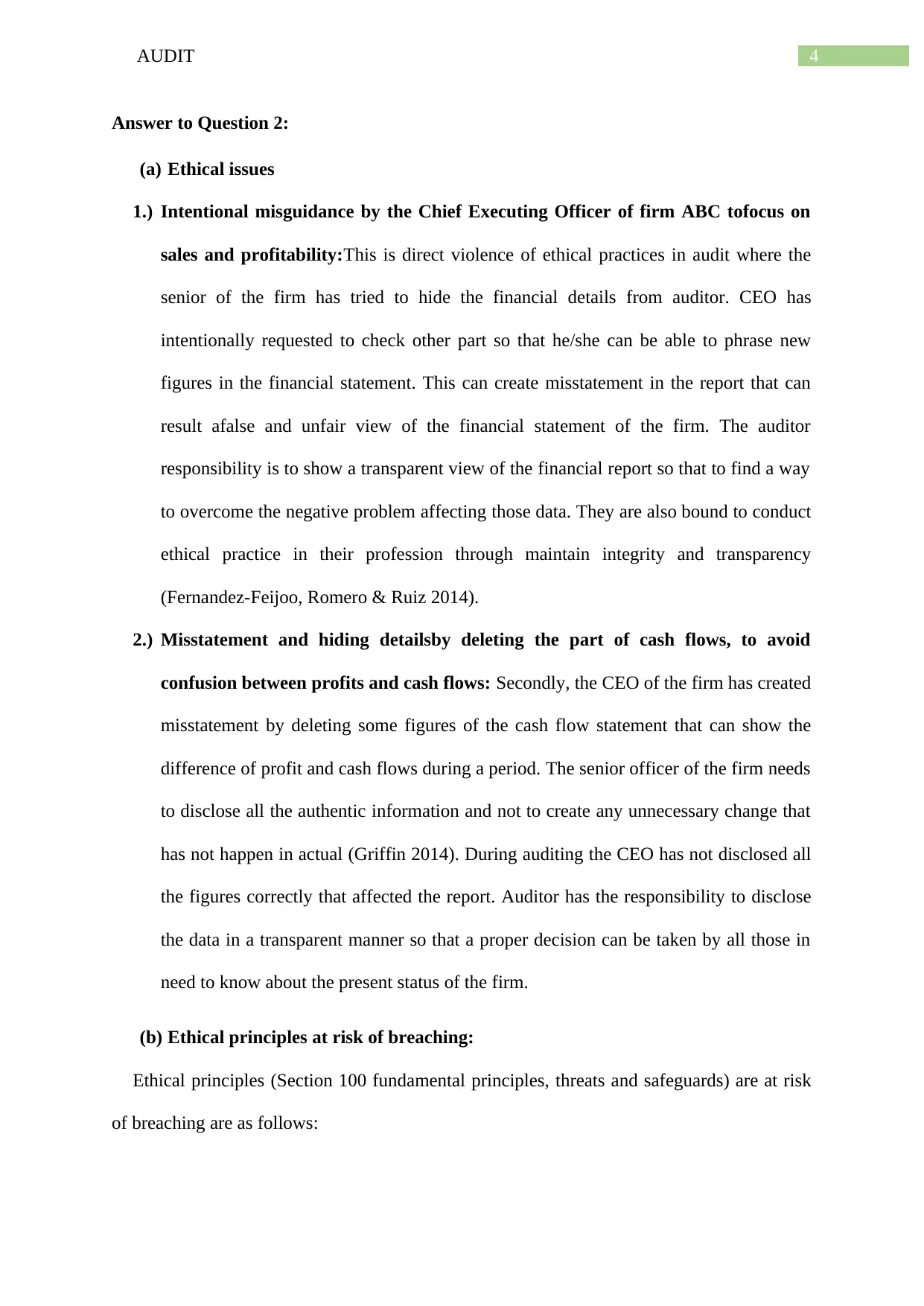
4AUDIT
Answer to Question 2:
(a) Ethical issues
1.) Intentional misguidance by the Chief Executing Officer of firm ABC tofocus on
sales and profitability:This is direct violence of ethical practices in audit where the
senior of the firm has tried to hide the financial details from auditor. CEO has
intentionally requested to check other part so that he/she can be able to phrase new
figures in the financial statement. This can create misstatement in the report that can
result afalse and unfair view of the financial statement of the firm. The auditor
responsibility is to show a transparent view of the financial report so that to find a way
to overcome the negative problem affecting those data. They are also bound to conduct
ethical practice in their profession through maintain integrity and transparency
(Fernandez-Feijoo, Romero & Ruiz 2014).
2.) Misstatement and hiding detailsby deleting the part of cash flows, to avoid
confusion between profits and cash flows: Secondly, the CEO of the firm has created
misstatement by deleting some figures of the cash flow statement that can show the
difference of profit and cash flows during a period. The senior officer of the firm needs
to disclose all the authentic information and not to create any unnecessary change that
has not happen in actual (Griffin 2014). During auditing the CEO has not disclosed all
the figures correctly that affected the report. Auditor has the responsibility to disclose
the data in a transparent manner so that a proper decision can be taken by all those in
need to know about the present status of the firm.
(b) Ethical principles at risk of breaching:
Ethical principles (Section 100 fundamental principles, threats and safeguards) are at risk
of breaching are as follows:
Answer to Question 2:
(a) Ethical issues
1.) Intentional misguidance by the Chief Executing Officer of firm ABC tofocus on
sales and profitability:This is direct violence of ethical practices in audit where the
senior of the firm has tried to hide the financial details from auditor. CEO has
intentionally requested to check other part so that he/she can be able to phrase new
figures in the financial statement. This can create misstatement in the report that can
result afalse and unfair view of the financial statement of the firm. The auditor
responsibility is to show a transparent view of the financial report so that to find a way
to overcome the negative problem affecting those data. They are also bound to conduct
ethical practice in their profession through maintain integrity and transparency
(Fernandez-Feijoo, Romero & Ruiz 2014).
2.) Misstatement and hiding detailsby deleting the part of cash flows, to avoid
confusion between profits and cash flows: Secondly, the CEO of the firm has created
misstatement by deleting some figures of the cash flow statement that can show the
difference of profit and cash flows during a period. The senior officer of the firm needs
to disclose all the authentic information and not to create any unnecessary change that
has not happen in actual (Griffin 2014). During auditing the CEO has not disclosed all
the figures correctly that affected the report. Auditor has the responsibility to disclose
the data in a transparent manner so that a proper decision can be taken by all those in
need to know about the present status of the firm.
(b) Ethical principles at risk of breaching:
Ethical principles (Section 100 fundamental principles, threats and safeguards) are at risk
of breaching are as follows:
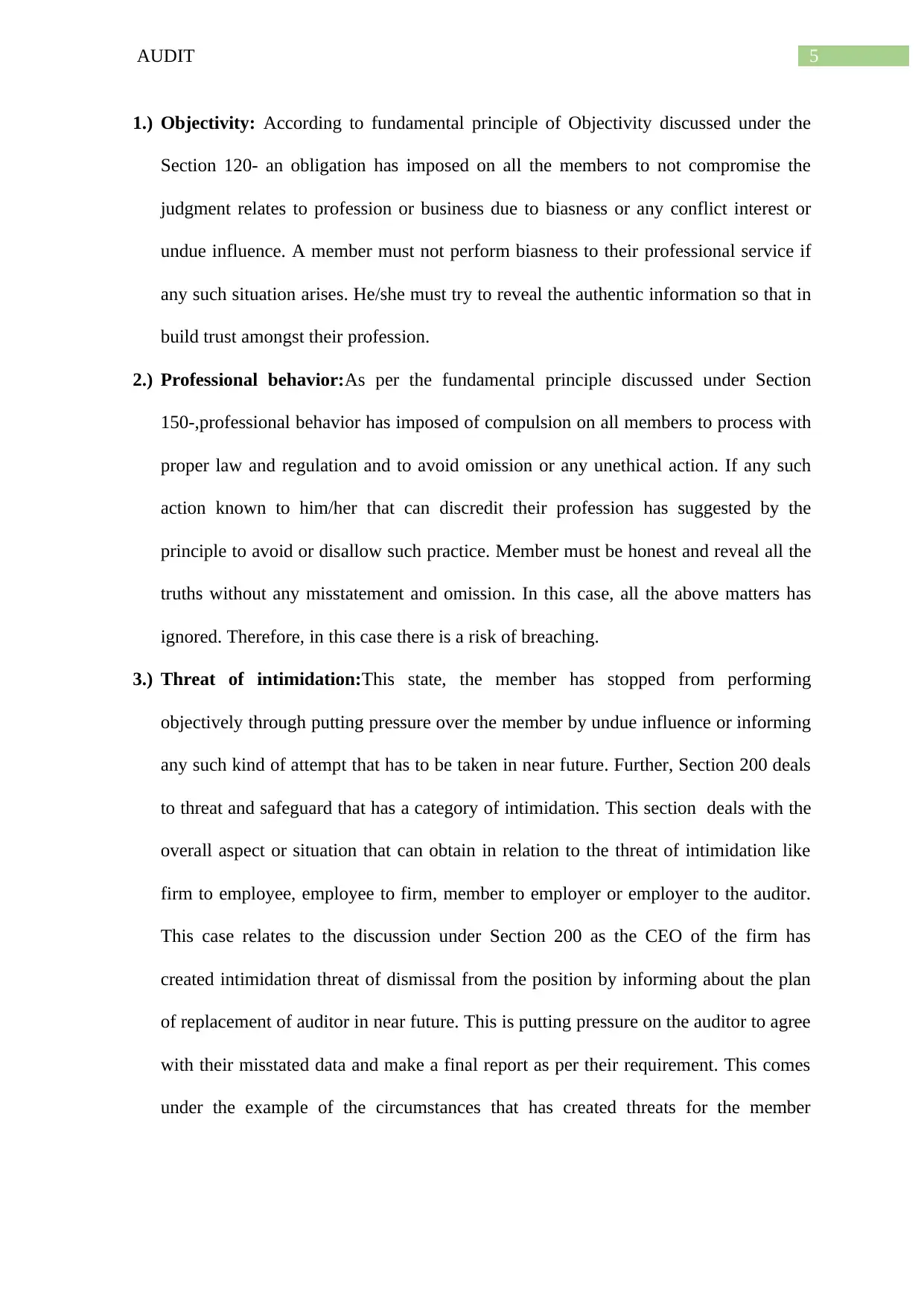
5AUDIT
1.) Objectivity: According to fundamental principle of Objectivity discussed under the
Section 120- an obligation has imposed on all the members to not compromise the
judgment relates to profession or business due to biasness or any conflict interest or
undue influence. A member must not perform biasness to their professional service if
any such situation arises. He/she must try to reveal the authentic information so that in
build trust amongst their profession.
2.) Professional behavior:As per the fundamental principle discussed under Section
150-,professional behavior has imposed of compulsion on all members to process with
proper law and regulation and to avoid omission or any unethical action. If any such
action known to him/her that can discredit their profession has suggested by the
principle to avoid or disallow such practice. Member must be honest and reveal all the
truths without any misstatement and omission. In this case, all the above matters has
ignored. Therefore, in this case there is a risk of breaching.
3.) Threat of intimidation:This state, the member has stopped from performing
objectively through putting pressure over the member by undue influence or informing
any such kind of attempt that has to be taken in near future. Further, Section 200 deals
to threat and safeguard that has a category of intimidation. This section deals with the
overall aspect or situation that can obtain in relation to the threat of intimidation like
firm to employee, employee to firm, member to employer or employer to the auditor.
This case relates to the discussion under Section 200 as the CEO of the firm has
created intimidation threat of dismissal from the position by informing about the plan
of replacement of auditor in near future. This is putting pressure on the auditor to agree
with their misstated data and make a final report as per their requirement. This comes
under the example of the circumstances that has created threats for the member
1.) Objectivity: According to fundamental principle of Objectivity discussed under the
Section 120- an obligation has imposed on all the members to not compromise the
judgment relates to profession or business due to biasness or any conflict interest or
undue influence. A member must not perform biasness to their professional service if
any such situation arises. He/she must try to reveal the authentic information so that in
build trust amongst their profession.
2.) Professional behavior:As per the fundamental principle discussed under Section
150-,professional behavior has imposed of compulsion on all members to process with
proper law and regulation and to avoid omission or any unethical action. If any such
action known to him/her that can discredit their profession has suggested by the
principle to avoid or disallow such practice. Member must be honest and reveal all the
truths without any misstatement and omission. In this case, all the above matters has
ignored. Therefore, in this case there is a risk of breaching.
3.) Threat of intimidation:This state, the member has stopped from performing
objectively through putting pressure over the member by undue influence or informing
any such kind of attempt that has to be taken in near future. Further, Section 200 deals
to threat and safeguard that has a category of intimidation. This section deals with the
overall aspect or situation that can obtain in relation to the threat of intimidation like
firm to employee, employee to firm, member to employer or employer to the auditor.
This case relates to the discussion under Section 200 as the CEO of the firm has
created intimidation threat of dismissal from the position by informing about the plan
of replacement of auditor in near future. This is putting pressure on the auditor to agree
with their misstated data and make a final report as per their requirement. This comes
under the example of the circumstances that has created threats for the member

6AUDIT
performing under public practice with certain laws, rules and regulations(Apesb.org.au
2019).
performing under public practice with certain laws, rules and regulations(Apesb.org.au
2019).
Paraphrase This Document
Need a fresh take? Get an instant paraphrase of this document with our AI Paraphraser
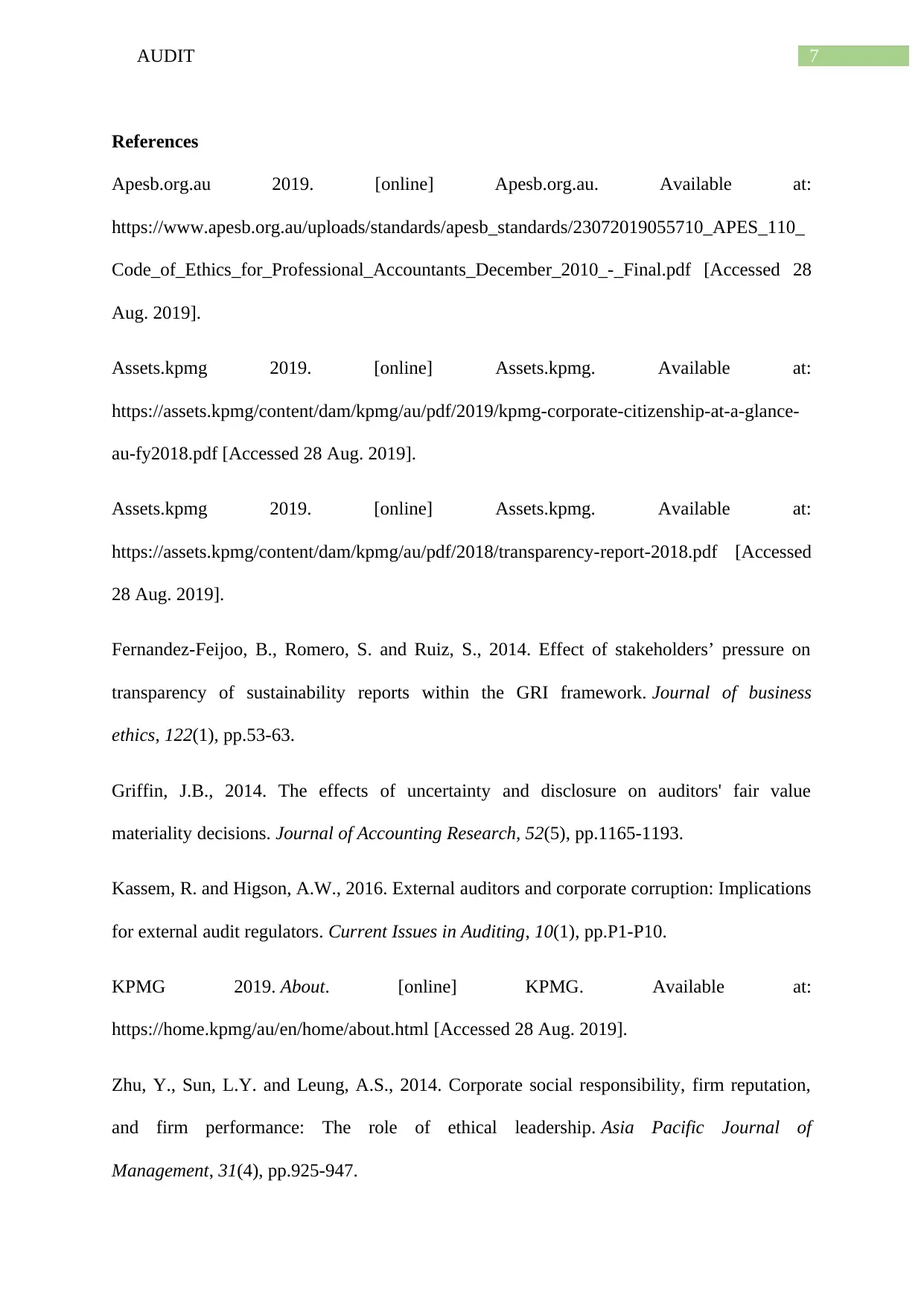
7AUDIT
References
Apesb.org.au 2019. [online] Apesb.org.au. Available at:
https://www.apesb.org.au/uploads/standards/apesb_standards/23072019055710_APES_110_
Code_of_Ethics_for_Professional_Accountants_December_2010_-_Final.pdf [Accessed 28
Aug. 2019].
Assets.kpmg 2019. [online] Assets.kpmg. Available at:
https://assets.kpmg/content/dam/kpmg/au/pdf/2019/kpmg-corporate-citizenship-at-a-glance-
au-fy2018.pdf [Accessed 28 Aug. 2019].
Assets.kpmg 2019. [online] Assets.kpmg. Available at:
https://assets.kpmg/content/dam/kpmg/au/pdf/2018/transparency-report-2018.pdf [Accessed
28 Aug. 2019].
Fernandez-Feijoo, B., Romero, S. and Ruiz, S., 2014. Effect of stakeholders’ pressure on
transparency of sustainability reports within the GRI framework. Journal of business
ethics, 122(1), pp.53-63.
Griffin, J.B., 2014. The effects of uncertainty and disclosure on auditors' fair value
materiality decisions. Journal of Accounting Research, 52(5), pp.1165-1193.
Kassem, R. and Higson, A.W., 2016. External auditors and corporate corruption: Implications
for external audit regulators. Current Issues in Auditing, 10(1), pp.P1-P10.
KPMG 2019. About. [online] KPMG. Available at:
https://home.kpmg/au/en/home/about.html [Accessed 28 Aug. 2019].
Zhu, Y., Sun, L.Y. and Leung, A.S., 2014. Corporate social responsibility, firm reputation,
and firm performance: The role of ethical leadership. Asia Pacific Journal of
Management, 31(4), pp.925-947.
References
Apesb.org.au 2019. [online] Apesb.org.au. Available at:
https://www.apesb.org.au/uploads/standards/apesb_standards/23072019055710_APES_110_
Code_of_Ethics_for_Professional_Accountants_December_2010_-_Final.pdf [Accessed 28
Aug. 2019].
Assets.kpmg 2019. [online] Assets.kpmg. Available at:
https://assets.kpmg/content/dam/kpmg/au/pdf/2019/kpmg-corporate-citizenship-at-a-glance-
au-fy2018.pdf [Accessed 28 Aug. 2019].
Assets.kpmg 2019. [online] Assets.kpmg. Available at:
https://assets.kpmg/content/dam/kpmg/au/pdf/2018/transparency-report-2018.pdf [Accessed
28 Aug. 2019].
Fernandez-Feijoo, B., Romero, S. and Ruiz, S., 2014. Effect of stakeholders’ pressure on
transparency of sustainability reports within the GRI framework. Journal of business
ethics, 122(1), pp.53-63.
Griffin, J.B., 2014. The effects of uncertainty and disclosure on auditors' fair value
materiality decisions. Journal of Accounting Research, 52(5), pp.1165-1193.
Kassem, R. and Higson, A.W., 2016. External auditors and corporate corruption: Implications
for external audit regulators. Current Issues in Auditing, 10(1), pp.P1-P10.
KPMG 2019. About. [online] KPMG. Available at:
https://home.kpmg/au/en/home/about.html [Accessed 28 Aug. 2019].
Zhu, Y., Sun, L.Y. and Leung, A.S., 2014. Corporate social responsibility, firm reputation,
and firm performance: The role of ethical leadership. Asia Pacific Journal of
Management, 31(4), pp.925-947.

8AUDIT

9AUDIT
1 out of 10
Related Documents
Your All-in-One AI-Powered Toolkit for Academic Success.
+13062052269
info@desklib.com
Available 24*7 on WhatsApp / Email
![[object Object]](/_next/static/media/star-bottom.7253800d.svg)
Unlock your academic potential
© 2024 | Zucol Services PVT LTD | All rights reserved.





